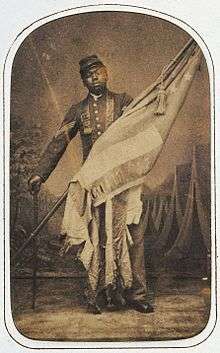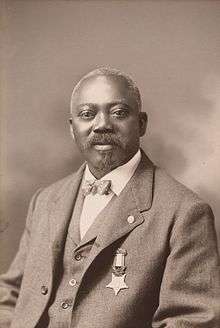William Harvey Carney
| William Harvey Carney | |
|---|---|
 | |
| Born |
February 29, 1840 Norfolk, Virginia, U.S. |
| Died |
December 9, 1908 (aged 68) New Bedford, Massachusetts, U.S. |
| Place of burial | Oak Grove Cemetery, New Bedford, Massachusetts, U.S. |
| Allegiance | United States (Union) |
| Service/ | U.S. Army (Union Army) |
| Years of service | 1863–1864 |
| Rank | Sergeant |
| Unit | 54th Massachusetts Volunteer Infantry |
| Battles/wars |
American Civil War Second Battle of Fort Wagner |
| Awards | Medal of Honor |
William Harvey Carney (February 29, 1840 – December 9, 1908) was an African American soldier during the American Civil War. Born as a slave, he was awarded the Medal of Honor in 1900 for his gallantry in saving the regimental colors (American Flag) during the Battle of Fort Wagner in 1863. Because his actions preceded those of other medal honorees, he is considered to be the first African American to be granted the Medal of Honor.
Biography
William H. Carney was born as a slave in Norfolk, Virginia, on February 29, 1840.[1] How he made his way to freedom is not certain. According to most accounts, he escaped through the Underground Railroad, and joined his father in Massachusetts. Other members of their family were freed by purchase or by the death of their master.[1][2]
Carney joined the 54th Massachusetts Volunteer Infantry in March 1863[1] as a sergeant. He took part in the July 18, 1863, assault on Fort Wagner in Charleston, South Carolina.[3] His actions there ultimately earned him the Medal of Honor. When the color guard was killed, Carney retrieved the U.S. flag and marched forward with it, despite multiple serious wounds.[1][4] When the Union troops were forced to retreat under fire, he struggled back across the battlefield, eventually returning to his own lines and turning over the colors to another survivor of the 54th, saying, "Boys, I only did my duty; the old flag never touched the ground!"[2] He received an honorable discharge due to disability from his wounds in June 1864.[1][5]
Post-war

After his discharge, Carney returned to New Bedford, Massachusetts, and took a job maintaining the city's streetlights. He then delivered mail for thirty-two years.[6][3] He was a founding vice president of the New Bedford Branch 18 of the National Association of Letter Carriers in 1890.[6] He married Susannah Williams, and they had a daughter, Clara Heronia.[3] He spent a few years in California, then returned again in 1869.
Carney received his Medal of Honor on May 23, 1900, nearly 37 years after the events at Fort Wagner. (More than half such awards from the Civil War were presented 20 or more years after the fact.)[2] Twenty African Americans had received the medal before him, but because his battle actions happened earlier than the others, he is generally considered the first.[1][2][7] His citation reads,
When the color sergeant was shot down, this soldier grasped the flag, led the way to the parapet, and planted the colors thereon. When the troops fell back he brought off the flag, under a fierce fire in which he was twice severely wounded.[8]
Carney died at the Boston City Hospital on December 9, 1908, of complications from an elevator accident at the Massachusetts State House where he worked for the Department of State. His body lay in state for one day at the undertaking rooms of Walden Banks 142 Lenox Street at the wish of his wife and daughter. It was buried in the family plot at Oak Grove Cemetery in New Bedford, Massachusetts.[9] Engraved on his tombstone is an image of the Medal of Honor.[9]
Other honors
Carney's face is shown on the monument to Robert Gould Shaw and the 54th on the Boston Common designed by Augustus Saint Gaudens.[2] A New Bedford, Massachusetts, elementary school was named in his honor,[1] and his New Bedford home at 128 Mill Street is listed on the National Register of Historic Places.[10]
In 2015, Carney was honored as one of the Library of Virginia's "Strong Men & Women in Virginia History" because of his actions during the Civil War.[11]
See also
References
- 1 2 3 4 5 6 7 "William H. Carney". Contemporary Black Biography. Detroit: Gale. 104. 8 March 2013. Retrieved 1 March 2015.
- 1 2 3 4 5 Carney, William Harvey. "William Harvey Carney (1840 - 1908)". The Center for African American Genealogical Research, Inc. Retrieved 1 March 2015.
- 1 2 3 William H. Carney. Notable Black American Men, Book II. Gale. 12 October 1998. Retrieved 1 March 2015.
- ↑ Marshall Jr., Tyrone C. (19 February 2013). "First African-American Medal of Honor Recipient Safeguarded Flag". State News Service. Retrieved 1 March 2015.
- ↑ Massachusetts soldiers, sailors, and marines in the civil war. Norwood, MA: Norwood Press. 1931. p. 670. Retrieved 1 March 2015.
- 1 2 Rubio, Philip (May 15, 2010). There's Always Work at the Post Office: African American Postal Workers and the Fight for Jobs, Justice, and Equality. University of North Carolina Press. pp. 16–18. ISBN 0807895733.
- ↑ Henig, Gerald S. (June 2009). "Glory at Battery Wagner: William H. Carney became the First Black Soldier to earn the Medal of Honor". Civil War Times. Retrieved 1 March 2015.
- ↑ "Medal of Honor recipients". American Civil War (A-L). United States Army Center of Military History. July 16, 2007. Retrieved 1 March 2015.
- 1 2 "William Harvey Carney". Claim to Fame: Medal of Honor recipients. Find a Grave. Retrieved 1 March 2015.
- ↑ "Carney, Sgt. William H. House". Massachusetts Cultural Resource Information System. Massachusetts Historical Commission. Retrieved 16 March 2015.
- ↑ "Strong Men & Women in Virginia History: William Harvey Carney (February 29, 1840–December 9, 1908)". Library of Virginia. Retrieved 2 March 2015.
External links
| Wikimedia Commons has media related to William Harvey Carney. |
- "William Harvey Carney". Hall of Valor. Military Times. Retrieved February 1, 2010.
- "Congressional Medal of Honor Society: William Harvey Carney". Congressional Medal of Honor Society. Retrieved February 24, 2010.
- "Sergeant Carney's Flag: The True Story of the First Black Medal of Honor recipient". Home of Heroes. Retrieved February 24, 2010.
- "Listen to Episode 57: But Who's Counting". The Way I Heard It with Mike Rowe. Retrieved May 23, 2017.